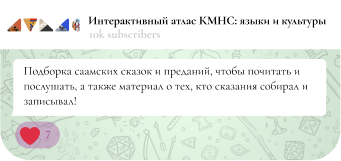|
|
Olga Kazakevich
Institute of Linguistics, Russian Academy of Sciences
|
Southern Selkup
I. Sociolinguistic Data
1. Language names
The name of Ostyak Samoyed was used since the days of M. Kastrena (mid-19th century) until the late 1930s
.
Then the notion of the Selkup language, encompassing both Northern and Southern Selkup dialects, was introduced into scientific and official use in the 1930s. It was based on the self-designation of the Northern group of Selkups. But the name did not catch on among Southern Selkups (Selkups of Tomsk Oblast), who continued to refer to themselves as Ostyaks, even in the 2002 and 2010 Censuses.
Speakers of Selkup idioms did not consider themselves as part of a single ethnic and linguistic group, which was reflected in various Selkup self-designations.
The self-designation of the language in the Northern group is
шöль ӄумын әты / шöй ӄумын әты
.
The self-designations of the language in the Selkup dialects of Tomsk Oblast are manifold and depend on the group:
—
чумыль ӄумыт әты / чумыль эҗ / чӯмыт шэ / чум шэ / чюмы шэ / чюм шэ̄ / чӯмыл шэ / чӯмӭльқут шэ
(Tym, Narym, Vasyugan, Parabeli dialects);
—
шӧш ӄумыт әты / шёшқуй шэ
(Middle Ob, Chaia, Lower Ket dialects);
—
сÿсÿгуй сэ
(Sondrovo subdialects);
—
тӱй ӄумыт әты
(Lower Chulym dialect)
—
сӱccӱ ӄумыт әты
(Middle and Upper Ket dialects)
Other names of the language: Central-Southern Selkup, Southern-Central Selkup, Selkup of Tomsk Oblast, language of Selkups of Tomsk Oblast.
Until recently, there was a question of a single Selkup language. Several years ago, it was suggested to divide it into two languages – Northern and Southern Selkup – based on numerous linguistic and sociolinguistic data. And while Northern Selkup is easy to see as a separate language with its dialect division, Southern Selkup is more like an array of separate dialects. The key arguments for combining these dialects into one single language and separating it from Northern Selkup were the lack of mutual intelligibility between these two variants and the lexicostatistical calculations that showed that the Southern dialects were close enough to be considered the dialects of the same language (the percentage of lexical similarity between them varies between 91 and 95%). An additional argument in favor of reuniting local variants of the Southern Selkup was the fact that it is currently on the verge of extinction and many of its dialects and even the entire dialect groups have no native speakers anymore, thus, these are just the remains of a former local diversity.
Since the days of G. Prokofyev, the self-designation
шёль ӄуп
was interpreted as ‘forest man’. This interpretation was generally accepted by both researchers and Northern Selkups themselves. However, the analysis of historical data over the last twenty years brought about several new suggestions. Yarmo Alatalo (2004) and Evgeny Khelimsky (2005) suggested that the self-designations of not only Northern Selkups, but also other Selkup groups all stemmed from the common language of Selkups *
sʲø
‘lord’ combined with a derivational suffix *
-sǝ
‘member of a family or a group’, i.e. ‘a man who belongs to the lord’s people or family’. In 2019, Anna Urmanchieva suggested yet another idea: to consider the self-designation of Selkups as an old loan word from the Northern Mansi language, where a similar word combination means ‘local person’ (c.f. Northern Mansi
sossɑ xum
).
2. General characteristics
Southern Selkups live in four districts in the north of Tomsk Oblast: Verkhneketsky, Kolpashevsky, Parabelsky, and Kargasogsky, as well as in Tomsk. The majority of old Selkup villages in Tomsk Oblast were closed down, and their inhabitants were resettled to bigger communities where they constitute a minority. The only exception is Napas on the Tym River (Kargasogsky District), former center of the Tym Selkup National District (1934 — 1948).
When it comes to traditional economy, customs, and numerous other elements, Selkups are particularly close to their two neighboring peoples, Khants and Kets. Due to their closeness, these three ethnic groups, although speaking very different languages, used to be referred to as
остяки
[Ostyaks] for a very long time. This name is still widely used in Tomsk Oblast by Russian old-timers when referring to Selkups, whereas Selkups themselves use it to define their own ethnic origin.
2.1. Total number of speakers and their ethnic group
Native speakers: 2 people. Source: respondents of the Census 2020 who indicated their proficiency.
Based on the results of sociolinguistic research carried out in 2010 and 2016, there were no more than 10 Southern Selkup speakers left after the 2010s, and this number included not only fluent speakers able to communicate in it (no more than 4 people), but also passive users. Over the last years, language courses allowed to create several new fluent speakers, but as far as we can tell, they are more used to writing Selkup than speaking it. So far, it’s difficult to say if these efforts to revive Selkup will bear any fruit in the future and help to save this language from extinction.
2.2.
Age structure of native speakers
Only four elderly people (65+) learned the language in their childhood and are proficient in it (two native speakers of Narym dialect, one of Ket dialect, and one of Middle Ob). In addition, there is one new proficient speaker, who learned the language through books at a young age (Middle Taz and Narym dialects) and is now teaching it at a language school. However, students of these language courses (from different age groups) are seriously lagging behind their teacher for the moment.
2.3. Sociolinguistic characteristics
2.3.1. General characteristics
In the early 19
th
century, all Selkups of Tomsk Oblast spoke their Selkup dialects. Very few of them spoke Russian. At the beginning of the 20
th
century, many Selkups of Tomsk Oblast, who lived along the Obi River, spoke Russian. The traditional areas of use of Southern Selkup included family, trade (hunting, fishing, and reindeer herding), oral folk art (folklore). Selkup was actively used in religious practice (Selkups were animists, they used shamans, capable of controlling helping spirits, to communicate with other worlds and the spirits of the surrounding world). However, the persecutions against shamans in the 1930-1940s have done some considerable damage: in all likelihood, there are no more shaman practitioners left among Southern Selkups, although the shaman tradition lives on. In the late 20
th
century, the Middle Ob dialect was occasionally taught at Ivankino school, on the Tugura River, at language courses in the Parabeli village. During the pandemic, the courses of the Middle Ob and Narym dialects were launched online.
At present, Middle Ob and Narym dialects of the Southern Selkup language are taught at the language courses in Kolpashevo (Middle Ket, by N. Izhembina) and Tomsk (Narym, by I. Korobeynikova and G. Korotkikh). During the pandemic, the courses were transferred online, where they continue to this date. For the moment, Selkup students are particularly good at acquiring the written form of the language. It is facilitated by the use of Middle Ob and Narym dialects in the online space, in particular, in several Southern Selkup chat rooms.
2.3.2. Vitality status
1B Dormant: Narym, Middle Ob, and Middle Ket dialects.
1A Extinct: Tym, Chaia, Vasyugan, Chulym, Upper Ob dialects.
2.2.3. Use in various spheres
|
Sphere
|
Use
|
Comments
|
|
Family and everyday communication
|
yes/no
|
|
|
Education: nursery schools
|
no
|
|
|
Education: school
|
no
|
|
|
Education: higher education
|
no
|
|
|
Education: language courses/clubs
|
courses
(+ if optional)
|
Courses of Middle Ob and Narym dialects
|
|
Media: press (incl. online editions)
|
no
|
|
|
Media: radio
|
no
|
|
|
Media: TV
|
no
|
|
|
Culture (incl. live folklore)
|
yes
|
Narym and Middle Ob dialects
|
|
Fiction in native language
|
yes
|
Narym dialect
|
|
Religion (use in religious practice)
|
no
|
|
|
Legislation + Administrative activities + Justice system
|
no
|
|
|
Agriculture (incl. hunting, gathering, reindeer herding, etc.)
|
no
|
|
|
Internet (communication/ existence of websites in native language, not media)
|
yes
|
Narym and Middle Ob dialects, on a small scale (see below)
|
There are Southern Selkup groups in Vkontakte:
Шё̄шӄуй шэ̄
✼
Чумӭл шэ
✼
Сӱ̄ссыӷӯй сэ̄ [Selkup Language TO
✼
Southern Selkup Language]
and
Южноселькупский Язык
[Southern Selkup Language].
2.4.
Information about written language
The first attempt to create a Selkup system of writing took place in the 19
th
century. In 1879, N. Grigorovsky elaborated and published a Selkup ABC and three small books with orthodox missionary content that were written in the Obsk dialect of Selkup using a Cyrillic-based alphabet. In 1900, Archbishop of Tomsk and Altai Macarius published another religious educational book in a close dialect, also using a Cyrillic-based alphabet. However, these attempts did not result in the spread of literacy among Selkups.
Since the dialects of Southern Selkup differ significantly from Northern Selkup, the schoolbooks created for the latter are unusable for the former. In the early 1990s, the Laboratory of the Indigenous Peoples of Siberia, Tomsk State Pedagogical University, developed a system of writing for the Southern Selkup dialects based on the Middle Ob dialect.
At first, this new Southern Selkup orthography was used mainly for education. The Selkup script was rarely used outside of schools and universities. This situation has changed with the arrival of the Internet, in particular, during the pandemic. Those who studied the Southern Selkup dialects began to write not just “because they had to”, but also “because they wanted to”. The Southern Selkup literature in Narym and Middle Ob dialects began to appear.
So far, the publications in Selkup include: an ABC in Middle Ob, two teach-yourself books in Middle Ob and three in Narym, a reading book (fairy tales) in Narym, a School Selkup-Russian and Russian-Selkup dictionary in Middle Ob, a picture vocabulary in Narym. School books are created by the researchers of the Laboratory (now, Department) of the Indigenous Peoples of Siberia, Tomsk State Pedagogical University, and linguist activists. Over the past several years, in addition to the actual educational literature, I. Korobeynikova, a language activist and one of the last two native Narym speakers, published several books of stories and song lyrics in this dialect with translations into Russian, as well as several translations of Russian texts into Narym. G. Korotkikh, a language activist, published a collection of short stories by the participants of his Narym courses with a translation into Russian.
Selkup Alphabet (Narym dialect) [Korotkikh 2022]
Аа А̄а̄ Ää Ǟǟ Бб Вв Гг Ӷӷ Ее Е̄е̄ Əə Ə̄ə̄ Ёё Ё̄ё̄ Жж Җҗ Зз Ии Ӣӣ и̇ и̇̄ Йй Кк Ӄӄ Лл Мм Нн ӈ Оо О̄о̄ Ө̄ө̄ Ӧӧ Ӧ̄ӧ̄ Пп Рр Сс Тт Уу Ӯӯ Ӱӱ Ӱ̄ӱ̄ Фф Хх ӽ Цц Чч Ҷҷ Шш Щщ ъ Ыы Ы̄ы̄ ь Ээ Э̄э̄ Юю Ю̄ю̄ Яя Я̄я̄
3. Geographic Characteristics
3.1. Subjects of the Russian Federation with compact residence of native speakers
Tomsk Oblast. Until recently, Southern Selkup speakers used to live in settlements of the following districts of Tomsk Oblast: Verkhneketsky, Kolpashevsky, Parabelsky, and Kargasogsky.
3.2. Total number of localities traditionally inhabited by native speakers:
12.
4. Historical Dynamics
In the early 19
th
century, nearly all Southern Selkups spoke their ethnic dialects. Some of those who live along the Obi River near Russian settlements knew some Russian. By the beginning of the 20
th
century, all Selkups living along the Obi River spoke Russian, and some of them switched to Russian completely. Their proficiency in Russian was facilitated by the intensive contacts with Russians that started in the 1920s along the Obi River, as well as Tym, Chaselku, Ket, and other tributaries of the Middle Ob, and the spread of school education among Selkup children. By the early 1950s, it has become commonplace for Selkups of Tomsk Oblast to speak Russian, and the linguistic shift from Selkup to Russian was well under way almost everywhere.
The traditional areas of use of Southern Selkup included family, trade (hunting, fishing, gathering wild plants), oral folk art (folklore). Selkup was actively used in religious practice as well (even though Selkups of Tomsk Oblast were baptized, they remained animists and used shamans, capable of controlling helping spirits, to communicate with other worlds and the spirits of the world). However, the persecutions against shamans in the 1930-1940s have done substantial damage. The evidence of last shamanistic rituals on the Ket River, where the Selkup shamanistic tradition seemed to have existed longer than on other tributaries of the Obi River, goes back to the 1960s. Today, in all likelihood, there are no more shaman practitioners left in Tomsk Oblast.
By the early 21
st
century, there were no more than 20-30 speakers of Central and Southern dialects, mainly very elderly, in Tomsk Oblast. By 2010, they were less than 10 people.
Nowadays, Russian is the key communication language for nearly all Selkups of Tomsk Oblast that speak Selkup to a certain extent.
The number of native speakers and corresponding ethnic group based on various censuses (starting from 1897) and other sources.
|
Census Year
|
Number of Native Speakers (men)
|
Size of Ethnic Group (men)
|
Comments
|
|
1897
|
|
5805
|
All Selkups (Ostyak Samoyeds), including Northern and Tomsk
|
|
1926
|
|
1630
|
This Census did not count Tomsk Selkups
|
|
1939
|
—
|
2604
|
All Selkups (Ostyak Samoyeds), Northern and Tomsk Selkups combined; no language-related data
|
|
1959
|
1923
|
3800
|
All Selkups, including Northern and Tomsk
|
|
1970
|
2188
|
4282
|
All Selkups, including Northern and Tomsk
|
|
1979
|
2145
|
3565
|
All Selkups, including Northern and Tomsk
|
|
1989
|
151
|
1347
|
|
|
2002
|
44
|
1787
|
|
|
2010
|
50
|
1181
|
|
|
2020
|
2
Southern Selkups
|
3 491
|
All Selkups, including Northern and Tomsk
|






















































